the NachtKabarett
All Writing & Content © Nick Kushner Unless Noted Otherwise
"We've started writing some new material, and the next record will probably be complete a lot sooner than the ones in the past, because those were much more of a personal journey. This one is very electronic. The two elements that have existed so far in what we've written are just very violent or very sexual. Other than that, I don't have a great description for it, other than that I've been referring to it as Marquis De Sade with a drum machine."Marilyn Manson. Autumn 2001.
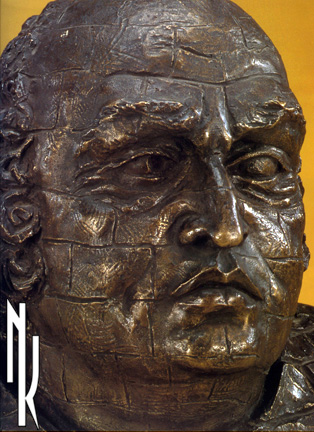 |
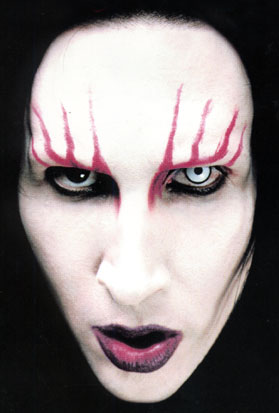 |
| Left, Imaginary Portrait if the Marquis de Sade, sculpture by Man Ray. As discussed in THE THIRD & FINAL BEAST section of The NACHTKABARETT in regard the more insidious connotations to Manson's "blinded" left eye, while imprisoned in Vicennes and then last at The Bastille, Sade lost sight of one of his eyes by his profilic writing and studies each night as a result of the strain of doing so in the dimness of his cell with only candlelight. | |
Along with Oscar Wilde, who was the "Arch Dandy" and one of the foremost figureheads of decadence in the Nineteenth Century, the Marquis de Sade was the other predominant literary influence on The Golden Age of Grotesque. Like Manson, Sade did not invent the horrors of the world which he portrayed in his writings and that he was persecuted for but instead reflected the realities of his era's decadence as well as an exaggerated portrayal of his own fetishes in his prose. During his lifetime he was able to see the entirety of his world turned upside down to then dizzyingly inverted back onto it's original axis of autocratic despotism under a different regime. Throughout this he was vilified and scapegoated for the corruption of the world and imprisoned at length without even a criminal conviction under solely by decree of the King, then later by Napoleon.
Having lived throughout pre-Revolutionary France, the chaos of the people's Revolution along with its bloody 8 year aftermath the Reign of Terror, to then the Napoleonic empire, Sade witnessed untold debaucheries, death, torture and cruelties which were far from being enacted by his own hand, and some more extreme than in his own writings. This in parallel to Manson, Sade was often blamed for these very elemental acts and inclinations of Man's own nature which he himself was subject to. Undoubtedly a befitting evocation, and one of similar plight, for Manson to pay tribute towards.
Sade, as most know him as and for the notoriety history ordained him with, was author of some of the most scandalous and licentious literature in human history. It was his family name in combination with his sexual inclinations (which he was often jailed for enacting) and the theme of his writings that Richard Freiherr von Krafft-Ebing in 1886 categorized the term for sexual pleasure as illicited by inflicting pain as 'Sadism'.
Behind this veil of subjective color which his name is dually glamorized and vilified for is a man imprisoned for the philosophy he chose to live by. Though by modern day terminology he may have been simply condemned as a sex offender, the pleasures Sade indulged in were that of (arguably mutual) power exchanges in fetishized whippings, beatings, spankings, followed by amorous fucking which by today's standards are common as day BDSM roleplay which is in fact in vogue. However in his own time period of pre-Revolutionary France where anal sex was punishable by death sentence these type of sexual aborations were not quite as widely accepted. In addition to consistently being accused of enacting the untold acts which his writings minutely details, many accounts of his own exploits were largely exaggerated, both for the sympathetic benefit of his alleged "victims" as well as the sensation prone and scandal hungry press (illustrating that times have changed very little from Sade's and our's).
Rumours of knife wounds across a young girl's ass cauterized with hot wax, orgies of sodomy after poisoning his muses with his experimentations with Spanish Fly and beatings accompanied by black magic invocations are among such scandals his name was blackened by, most often originating from a kernel of truth but with dubious sensationalized improvisations by press and witness are none seeming any more outlandish than removing one's ribs to perform self fellatio.
"In solitude and imprisonment, Sade "began to construct a kingdom of his own within the confines of his prison room. He would be the actor rather than the victim, supreme in his own thoughts and imagination. He still wanted his freedom but the letters in which he argued for it began to develop a second preoccupation. If there could be no escape outwards through the massive walls of Vicennes, perhaps there might be an escape inwards. The letters began to carry the more routine demands of a prisoner for books, writing materials, and the candles without which the books and pens would be useless in the gloom of the medieval keep. These provisions were not a mere anodyne against the slow agony of solitude. The were the foundations upon which a new world was to be built. Day by day in the letters it seemed that he was redefining his own view of himself. He was not to be a weeping petitioner but the heroic and unbroken champion of his own cause. There were those who had expected him to go mad, as other men did after years of such captivity. But he was not to go mad. On the contrary, he was to shock the minds of his bourgeois readers by a terrifying intellectual clarity. He would employ his sanity against his enemies as though it were a weapon of total war. Even if Sade had not yet sought salvation through writing novels, the ideas which were to feature in his fiction were soon to preoccupy him in his letters."From The Marquis de Sade: A New Biography by Donald Thomas, a recommended reading and predominant source on Sade's life and times in this article
Sade's philosophy was that of libertinage and as a libertine one is not bound to the subjective religious and moral confines of the society which he lives in. As such, a libertine can live as he pleases, write what he pleases and fuck whomever he chooses to fuck, as debauched or indulgent as he chooses to immerse himself. The practice of libertinage is often associated with those of wealth and power because they, unlike the "lowly plebeians", have the mobility and lesser fear of repercussion from such actions. Many of those other artists and authors written of throughout The NACHTKABARETT can be considered libertines by the decadence of their thoughts and actions, in a dimension as a precursor to Aleister Crowley's "Do What Thou Wilt" and the Law of Thelema.
As discussed in the ART & THE GOLDEN AGE OF GROTESQUE section of The NACHTKABARETT, the ethos of Dada and Surrealism was a very significant influence upon that album and era. The early surrealists venerated Sade (as does this current author in his artworks) as a hero of the movement who represented the embodiment of "The Surrealist Man" because he and his philosophy was, and remains, the antithesis of the morals of society, as they themselves were reacting in incendiary fashion for those similar aims. In homage, many of the early Surrealists such as Andre Breton, Salvador Dali, Man Ray and Hans Bellmer went so far as to create entire series of artworks in tribute to Sade, his work and his place in history.
"The complete theme is still under wraps. But it definitely lends itself to some of the things that have inspired me over the past year, particularly the life of the Marquis De Sade. I relate to how he was a person who had a very vivid imagination that scared a lot of people and he was punished for the things that were going on in his head. He was using his mind and his art to exorcise his demons, and he was punished for it. And I feel a lot of times I get myself into similar circumstances."
 "Manson Hits The UK for a Typically Understated Album Launch Party"
"Manson Hits The UK for a Typically Understated Album Launch Party"Marilyn Manson came to party and decorated London's Rouge nightclub in a glamorous 1930's European style for his exclusive Grotesk Burlesk party. Wandering around the venue all night were models in their undies and fans who traveled across Europe to attend. In the early hours Manson got on the roof and screamed obscenities at passer-by."NME, April 2003
"Sade none the less less concluded that the present period of public disorder represented his best chance of freedom after twelve years as a prisoner.From The Marquis de Sade: A New Biography by Donald Thomas.
"On 2 July 1789, he improvised a megaphone from a funnel that was used for emptying slops and gained the window of his room. Below him, the nearer streets were crowded with local people in the summer afternoon. Using his megaphone, Sade hailed them and began his harangue. According to witnesses, he shouted that the guards had been given orders to kill all the prisoners in the Bastille and that they were even now preparing to cut the throats of the inmates. "I stirred up the spirit of the people from my window," he wrote, "I drew them together below it. I warned them of the preparations being made in the Bastille and urged them to tear down this monument of horrors. All that is true." His words ranf across the square and the crowd began to pay attention. As there was a response to this and a murmuring of interest, Sade urged them to be quick, if they intended to attempt a rescue."
 Jean Benoit, Invitation of the Execution of the Testament of the Marquis de Sade, 2 December 1959
Jean Benoit, Invitation of the Execution of the Testament of the Marquis de Sade, 2 December 1959For more, and related to Manson's current endeavors and the evocations of Sade by the Surrealist movement, see below.
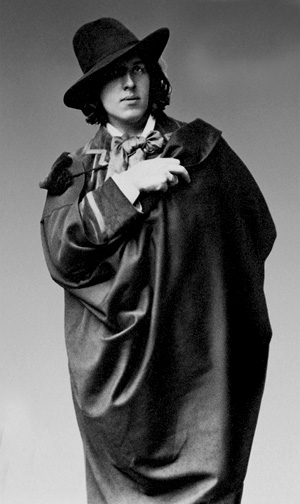 |
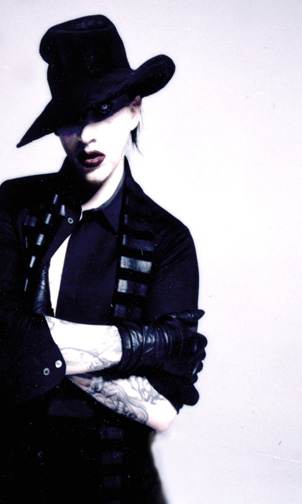 |
| Left, Oscar Wilde, one of the foremost influences on Manson's writings during The Golden Age of Grotesque and, right, Manson in the Summer of 2005 in the first online press release of the forthcoming Phantasmagoria film. | |
Throughout the Golden Age of Grotesque era interviews Manson has at multiple occasions cited Wilde as a huge influence on him for both his life and writings. Also stating that his favourite works of Wilde's are his aphorisms. It should come as no small stretch of artistic foray that it was also this very time period where Manson stated he would be releasing a book of his own aphorisms and statements (which is as of this writing, March 2007, still forthcoming).
For more on Oscar Wilde, his collaborator, peer and lover, Aubrey Beardsley and the "Arch Dandy" persona Manson personified throughout The Golden Age of Grotesque see the ART & THE GOLDEN AGE OF GROTESQUE section of The NACHTKABARETT.

"We want a Venus not In Furs but in uniforms, If you're not dancing then you're dead"
The above as Manson sung on the Scat / Swing inspired Doll-Dagga Buzz-Buzz Ziggety-Zag. If the term 'Sadism' was derived from The Marquis de Sade and the inclinations of the protagonists in his writings then so the term 'Masochism' is derived from Leopold Sacher-Masoch, the author of the novel Venus in Furs. Inspired by a painting of Venus admiring in a mirror with adornments of fur Sacher-Masoch's lasting contribution to the world of literature was his tale of man enamored so by a modern-day Venusian goddess, whose marble-pale skin and sculpted body inspire his complete submission to her dominant whims to the extreme so dire it results in near the loss of his very life. The novel's influence has been so long lasting in the form of art, song, and plays inspired by, that its author's name has been immortalized as the label of the fetish which dominated the novel.
It is a subtle, short yet memorable allusion Manson made within The Golden Age of Grotesque in reflection of the more "romantic" nature of his song writing seen throughout the album that his future works promise to follow in vein of.

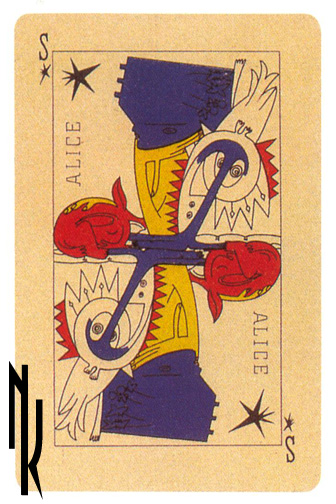
Conducted by movement founder Andre Breton, in the later progressive stages of the Surrealist movement a collaboratory project was embarked upon by a collective of the artists to create a deck of 'Surrealist playing cards' based on the Renaissance Tarot deck of Marseilles. The suites of this deck would be "the flame (signifying love), the black star (signifying dream), the wheel (signifying revolution), and the lock (signifying knowledge)". The the court cards representing figures which were ideals and icons of the Surrealist movement, including figures such as Freud, Georg Hegel, Baudelaire, the Marquis de Sade and Lewis Carroll's Alice.
Wilfredo Lam, 'Alice' card, Le Jeu de Marseilles / Marseilles Deck of Cards, 1940. Lewis Carroll's Alice's Adventures in Wonderland (1985) was one of the books favoured by the Surrealists and Alice was selected for the deck as a 'siren of dream'.Surrealism and the Politics of Eros, 1938 - 1968
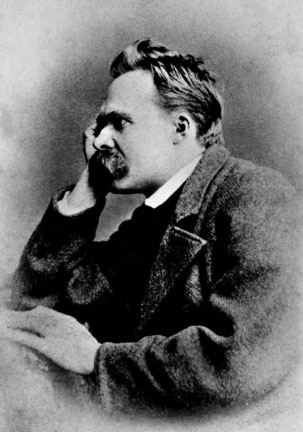
Friedrich Nietzsche (German philosopher, 1844 - 1900) is the man who boldly proclaimed that "GOD IS DEAD", by proxy of the revelatory guide in his Thus Spake Zarathustra. With this was set the tone for all incendiary art and thought to follow in the next century that he lived just long enough to usher in. His books include The Antichrist and much like Manson his teachings were perverted and misinterpreted to for self serving means both in during his life and posthumously.
The staple and most familiar subject of his writings is that of the Ubermensch, or super/overman. It was this facet which was the most powerful yet so grossly misinterpreted extending even to present day. He is most notoriously linked to the ideology of Nazism due to this very teaching yet it was one of the most inappropriate philosophical juxtapositions and misreadings Western society has seen since. The concept and embodiment of the 'Superman' or 'Overman' is the theme of transcendence and transformation, quite similar to that which Manson's writings center around and particularly so in Antichrist Svperstar with the metaphor of the Worm's transformation into the Angel. Manson has gone on to state via interview that Antichrist Svperstar was a tribute to Nietzsche's writings.
A more in-depth overview of Manson's evocations of Nietzsche's philosophies to follow in a future update.
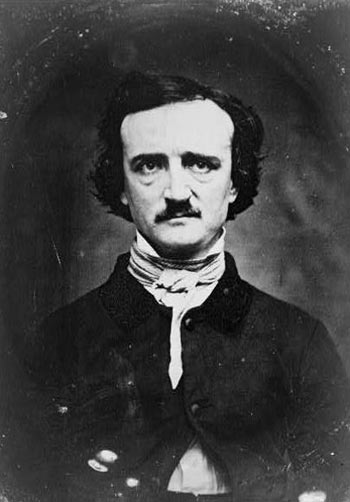 Photograph of Edgar Allan Poe
Photograph of Edgar Allan Poe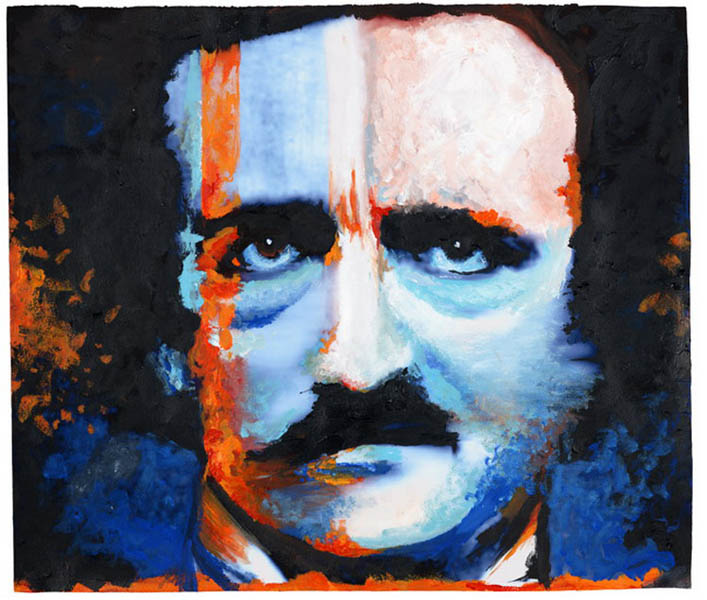 Manson's Watercolor Painting of Poe
Manson's Watercolor Painting of Poe
A pill to make you numb A pill to make you dumb A pill to make you anybody else
"It's A Depraved New World, After All". Huxley and Brave New World are influences which have perennially appeared in Manson's works from past to present. His cornerstone novel is something of an alternate and more drug sedated variation of the future present in George Orwell's 1984 (also a large influence upon Manson's works).

The drug saturated and self medicated future was presented largely by Manson in Mechanical Animals where humans have become so removed from humanity and their emotions that they cease to be so, devolving into automatonic, hollow shells of their former selves through drugs, sex, television and religious blind faith.
Wake up, inject a fix to charge the battery and discard the soul.
There's a hole in our soul that we fill with dope And we're feeling fine
It was Holy Wood however where Huxley and his alternate future were much more directly evoked in lyric along with the storyline being a reminiscent or variant retelling of Brave New World. Manson has never shrouded his employ of drugs during the creative process and in the November 2000 HIGH TIMES cover story of Holy Wood, M noted that the main drugs the band were involved with while writing the album were absinthe and Soma. The latter being the euphoric, government mandated self-intoxicant of Brave New World.
Soma plays an important role in Huxley's Brave New World; taken regularly by the people in tablet form, it is the 'opium of the masses'. Described as a narcotic tranquilizer, soma also displays properties of a powerful stimulant and hallucinogen, inducing (albeit fraudulent and hallucinatory) feelings of happiness and euphoria, rendering it also as a potent antidepressant. As such, soma serves the malevolent purpose of maintaining the hedonistic society. Conditioned to search for pleasure and chemically mask their pain, the people's ability to even consider insurrection is nearly entirely eliminated. And, contained within the Mechanical Animals booklet (and even the CD itself, which is nothing more than one large pill), are countless allusions to soma.
 From the Mechanical Animals Insert, 325 milligrams of 'Coma'
From the Mechanical Animals Insert, 325 milligrams of 'Coma'A society propped up by the pillars of sex, drugs, and distractions -- the people are blinded and presented an illusion of happiness, at the loss of freedom and free thought. Rather than living in a world of diversity, uncertainty and limitless possibility, the people quickly herd to whoever can offer them the quickest escape from their reality.
 A new day, don't forget the soma
A new day, don't forget the somaSoma however, has the potential to become progressively more harmful when taken in large quantities. Certain individuals, such as Savage's mother, Linda, develop a tolerance to the Soma and take increasingly higher and higher dosages in an attempt to match or prolong the euphoric sensations which were initially felt at the beginning of their substance abuse:
"Greedily she clamoured for ever larger, ever more frequent doses. Dr. Shaw at first demurred; then let her have what she wanted. She took as much as twenty grammes a day. "Which will finish her off in a month or two," the doctor confided to Bernard. "One day the respiratory centre will be paralyzed. No more breathing. Finished. And a good thing too. If we could rejuvenate, of course it would be different. But we can't."
Taken analytically, on the most basic of levels, soma may suggest a corrosive quality or intangible pursuit, which can ultimately result in complete self-destruction.
Mechanical Animals can as such be seen very much in tune with the Brave New World of Huxley; "millions of capsules and mechanical animals", a "city filled with dead stars", stripped and reduced of the human element; all that remains left soulless and spent.
Manson also specifically references Huxley in "Target Audience (Narcissus Narcosis) from Holy Wood. The title alone echoes Huxley's name, suggesting an unhealthy level of vanity, idolatry and drug abuse.
"Am I sorry you killed the Kennedy's and Huxley too?"
The pairing of Kennedy and Huxley should not be taken as inconsequential, as both men (of whom Manson has made numerous references to) were inevitably fatally linked together by the date of their death, November 22nd, 1963.
Another novel by Aldous Huxley which may have served as inspiration to Marilyn is "Ape and Essence", published in 1948. Like Brave New World, it is set in a dystopian society. Satirical, pessimistic, and nihilistic, it offers a bleak outlook on the human condition. Marked by heavy use of surrealism and metaphor, humans are often depicted as apes, primitive, and simplistic, with their true talent being the manner and ability in which they kill themselves.
 The cover to Aldous Huxley's "Ape and Essence"
The cover to Aldous Huxley's "Ape and Essence"Since Portrait of an American Family, monkeys and apes have played a recurringly large role in the world of metaphor and allusion that Manson has made in a similar satirical yet frank fashion as Huxley in "Ape and Essence". Such comparisons between men and apes causes us to fundamentally question and examine what makes us human, while posing the possibility that perhaps we aren't quite moving in the direction we'd like to be on the evolutionary chart.
"I'm a black rainbow and I'm an Ape of God, I've got a face that's made for violence upon. I'm a teen distortion, survived abortion, A Rebel From The Waiste Down"
The latter line of this verse from 'Disposable Teens' is taken from the aforementioned 1984. Orwell's classic written in 1948 is the prophetic nightmare vision of the future world of perpetual surveillance and authoritarianism at the hands of "Big Brother", the personified panopticon which society has reeled in horror from the threat of and conversely anticipated since the novel was published.
1984 has been referenced several times directly and offhandedly by Manson since his beginnings. The earlier line from Holy Wood, in specific, is uttered in the disaffected youth anthem 'Disposable Teens', in reference to Kate who is a Party member of the bureaucracy but consents to promiscuous sex, that in itself in that society was deemed as rebellion as it is the antithesis of the Party's desire to dehumanize and automatize mankind and regarded sex as contradictory to this but hollow as a rebellion as it only lasts until orgasm and does not extend to any further reaching extent that venereal penetration.
"From A Dead Man, Greetings..."
Thus the line which opened 'The Minute of Decay' on Antichrist Svperstar is actually a sample from the filmis version of 1984, starring William Hurt as the protagonist, Winston, in the year of its title (Hurt, who as an inverse of fate, played the role of "Big Brother" himself in 'V for Vendetta', the Double Cross of Lorraine laden film Manson was thought, though without evidence, as having involvement with in early 2006). 1984's later reference on Holy Wood 4 years later ties together an aspect of the two book ends of Manson's Triptych, the End and the Beginning, Antichrist Svperstar and Holy Wood. Again the line is in reference to the dehumanization of man which, as a personal allegory or else an indictment of Western Christian society, is a fitting and complementary citation in Manson's art. Expounding; the alternate and live closing of Antichrist Svperstar's title track is "You might as well kill yourself, you're already dead."
Tangential, albeit another noteworthy mention is that David Bowie's 'Diamond Dogs' is a concept album loosely based on 1984, and also an album which Manson has specifically quoted, as of late 2004, as being an influence to his current musical direction.
Though not referenced overtly, 1984 relates, like Huxely's 'Brave New World', most integrally with Mechanical Animals and its soulless inheritors of the future as Manson sonically paints the world. If taken as an inspiration basis for the allegory of Manson three-album Triptych, the echoes of 1984 can be heard throughout. As discussed at length and multiple times elsewhere throughout The NACHTKARARETT, The Triptych is the story of Adam who grows up disaffected in a heartless, unfeeling world, raised on the violence the society he was born into worships. With contempt yet a conflicting desire to at once be a part of the status quo he loathes, Adam sets out as an insurrectionist upstart to unleash a revolution against the world which has beaten him down. The further complexities and plot lines of Manson parable notwithstanding, what is evident is the parallelism to Orwell's novelian hero, Winston, who desires to destroy and internally tear down the edifice and forces which have lifelong oppressed him.

For in-depth correspondences to Marilyn Manson and Aleister Crowley see also The OCCULT and CELEBRITARIAN CORPORATION sections of The NACHTKABARETT









